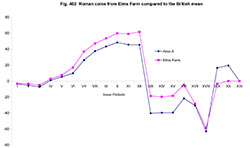
Cite this as: Guest, P. 2015, The Roman Coins, in M. Atkinson and S.J. Preston Heybridge: A Late Iron Age and Roman Settlement, Excavations at Elms Farm 1993-5, Internet Archaeology 40. http://dx.doi.org/10.11141/ia.40.1.guest
The excavations produced 2,910 Roman and 16 post-Roman coins. Of the Roman coins 2,842 were classified as site-finds, while a further 68 were found together as a hoard. Not all of the coins were cleaned and, of those that were, not all of their surfaces were necessarily eventually cleaned (revealing a particular area of a coin, such as the exergue or obverse legend, usually enabled the coin to receive as complete an identification as was possible under the circumstances). A consequence of this method of cleaning large numbers of coins is, however, that detailed studies of particular coin types are not possible for this assemblage. There was little point weighing the Claudian imitations, for example, because any corrosion products would have been included in their weights. The coins will be deposited at Colchester Museum and thus are available for further cleaning and study in the future. Further post-excavation work has produced higher coin totals and it should be noted that this report is based on the sample of 2910 coins studied. A full coin list is held in the archive.
The majority of the coins were found unstratified (59.6%), particularly from the topsoil layers that were usually removed by machine. At Colchester, it was suggested that the machining of certain layers, often those associated with the later Roman period, caused the loss of many of the latest coins and thereby biased the site histograms in favour of earlier coins (Crummy 1987, 5-7). At Elms Farm, however, metal-detectors were used at all stages of the excavation and the assemblage is much less likely to be biased towards one period of coinage than another. Figure 402 shows that the coins from topsoil layers are very similar to those from stratified deposits, indicating that the topsoil coins are a representative sample of the total assemblage. This is more likely to occur on a site that was either seriously disturbed by later activity, or was not deeply stratified (like many Romano-British rural settlements the latter was clearly the case).

The 1745 coins from the topsoil are allocated with the site code and to Area A (consisting of A1, A2 and A4). Where these coins could be identified they were included in the chronological analysis of the assemblage. They were not included, however, in the spatial study of coin loss as it was not always possible to allocate an unstratified coin to a specific enough area of the settlement. A further 195 Roman coins were recovered from other machining layers (17000) and allocated to Area Q. This context extended across the entire excavation and it is not possible to locate most of these coins to particular parts of the site. For this reason, Area Q coins (like those from Area A) were included in the chronological discussion but not the spatial analysis of the assemblage. Other area codes were given to coins recovered during the detecting of off-site spoilheaps (B, C and X), though these groups have been included in the spatial study as their original find-spots can be relatively closely located within the settlement.
See Figure 414 (.pdf)
The only coins of the Republic are two worn denarii of Marc Antony, struck immediately before the battle at Actium in 31 BC. These coins were struck at a far lower silver standard than contemporary denarii and it can be seen from hoards that they circulated in Britain throughout the 1st and 2nd centuries AD. They had disappeared from circulation by the end of the 2nd century, by which time the standard of officially produced denarii had fallen significantly below that of these legionary issues.
The six coins of the early Principate, struck before the invasion, include four asses, a semis and a Tiberian denarius. Although none of the pre-invasion coins were recovered from stratified deposits, it is most likely that they entered Britain either with the invading army, or immediately afterwards. Two of the asses and the semis were struck at Lugdunum, the mint that had supplied the military campaigns of Augustus but ceased to strike large quantities of bronze soon after AD 14.
In the period immediately after the invasion in AD 43 the Roman bronze coinage in Britain consisted of a small quantity of pre-Claudian denominations and a very large body of Claudian copies. Like almost all Romano-British sites, Elms Farm produced a far greater number of imitations than official aes of Claudius (the ratio of official to unofficial asses is 1:7, and for the dupondius 1:3). The copying of Claudian asses and dupondii began on the continent before the invasion of AD 43 and continued soon after the Roman army established itself in Britain. Pre-Claudian bronze coins were in short supply in the northern provinces of the empire, particularly after Claudius had demonetised the coins of Gaius in AD 44 (coin SF3365 is an overstrike of an unidentified aes of Gaius).
The majority of the Claudian copies from Elms Farm are imitations of the as; a characteristic common to most Romano-British assemblages. Twenty-one of the twenty-four copies are asses (87%), with three further imitations of dupondii (13%) and no examples of copied sestertii (see Kenyon 1987, 40, for similar figures from Colchester). The most commonly copied reverse for the as was the 'Minerva' type (RIC 100), accounting for seventeen coins. In this respect the Elms Farm group of 'Claudian copies' follows the Romano-British norm once again as the 'Minerva' type was the most frequently copied reverse throughout the period of production (Constantia - RIC 95, and Liberty - RIC 97 are present in smaller quantities). Copies of Claudian dupondii are always less common than asses and Elms Farm produced only three of these imitations. The prototypes for these coins are the 'Antonia' obverse bust (RIC 92) and the 'Ceres' reverse (RIC 94), both of which were commonly copied types.
The overwhelming quantity of Claudian copies compared with official coins is suggestive of increased activity towards the end of the counterfeiting epidemic, before Neronian aes were introduced. The Claudian copies from Elms Farm indicate that coins were circulating relatively freely, in Essex at least, between Roman military installations and rural settlements probably very soon after the invasion. Although Claudian copies have been found in contexts as late as the 3rd century, it is now certain that the small quantities of such coins circulating beyond the 70s were the exception rather than the rule (Kenyon 1987, 30-1). The seven stratified Claudian copies support this dating scheme. Six were found in contexts dated to Period 3 (later 1st to mid-2nd centuries), while the seventh was recovered from a Period 2 deposit and probably dates to the years immediately after AD 43.
In AD 64, the mint at Lugdunum was reopened and soon came to supply the vast majority of bronze coins to Roman Britain (Walker 1988, 285-6). Most bronze coins of Nero, Vespasian and Domitian recovered from Britain were struck there, although individual years saw varying levels of production. Almost all of Vespasian's coins were struck in one short episode of intensive output; of those that could be closely dated, eight were struck between AD 71-3, while only one was from AD 77-78. At this time the Rome mint was the sole producer of denarii and, although they comprise a relatively high proportion of Vespasian's coins at Elms Farm, this silver coin is much less common than bronze denominations from most Romano-British settlements. The Lugdunum mint was largely dormant under Domitian, but despite this Rome did not increase production of bronze coinage and Roman Britain received few new coins during most of Domitian's reign - except during 86-87 (65% of the recorded Domitianic coins were struck during these two years). Typically for a Romano-British site, those coins of this period that reached Heybridge were mainly asses. Of Domitian's forty-six coins, thirty-one were asses and another seven were dupondii. Elms Farm is unusual, however, as it produced two semisses of Nero, SF4111 and SF6100, an uncommon denomination in Roman Britain that did not appear once at the Sacred Spring at Bath, although two examples were identified at Richborough. Even though bronze coinage was supplied to Britain only episodically, the years of low supply produced only a single copy at Elms Farm; an as of Nero showing Victoria on the reverse (SF1722).
During the reigns of Nerva, Trajan and Hadrian bronze coinage was supplied more regularly to Britain. The excavations did not produce many coins, however, from issues that are known to have been sent exclusively to Britain under Hadrian (probably with the army that accompanied the emperor on his visit in AD 122). This pattern is in contrast to the situation at Bath where these issues are common. From Trajan's reign we see the increasing importance of the sestertius and dupondius, while the volume of new asses in circulation declined. Not all Romano-British sites followed the same patterns, however, and Elms Farm produced considerably more sestertii than the Sacred Spring at Bath (59% compared to 36%). Coin SF3930 is an example of an orichalcum semis or as of Trajan thought to have been struck at Antioch in AD 115-16 and brought to Britain during Hadrian's visit. These coins are often very worn, suggesting a long period of circulation.
Coins of the Antonine emperors mainly consist of the bronze denominations and the sestertius remained the most common coin. Sestertii represent 43% of Antoninus Pius' coins, a proportion that increases to 53% and 63% under Marcus Aurelius and Commodus respectively (a similar pattern was observed at Richborough). It is thought that the bulk of Antoninus Pius' bronze coinage was struck during a short period between AD 153-5; the Britannia asses, as well as Britannia and Libertas dupondii, all circulated almost exclusively in Britain and must have been delivered directly to the province without being introduced into circulation elsewhere. Other so-called 'Britannia' issues include dupondii of Marcus Caesar with Mars on the reverse (RIC 1322), and 'Aeternitas' dupondii and asses struck for Diva Faustina I (Hobley 1998, 65-70). Of the sixteen asses of Antoninus Pius whose reverse types were identified, only nine were from the Britannia issues (56% compared to 71% from the Sacred Spring at Bath). On the other hand, coins of other 'Britannia' types account for all four identifiable dupondii and asses struck in the name of Diva Faustina I.
The 190s witnessed two events that would dramatically affect the coins available to the population of Roman Britain. The first was Severus' debasement of the denarius in AD 194/5 that reduced its fineness to approximately 50%, and the second was the end of virtually all supplies of bronze coinage to provinces north of the Alps after AD 197. Bronze denominations continued to be struck in considerable quantities until c. AD 260, although their use was restricted to the central parts of the empire. In Britain, a period of almost forty years followed during which the supply of bronze coins quickly dried up to no more than a trickle and new coins comprised mostly the debased silver denarius. Of the sixty-nine coins struck between AD 193 and AD 238, fifty-six are denarii and three are denarius forgeries. The remaining Severan coins comprise eight sestertii, an interesting copy of an Elagabalan as with the reverse VICTOR ANTONINI AVG (SF646), and a silver quinarius of an unidentified Severan emperor (SF3639). It is interesting that a significant number of Severan denarii have been broken or deliberately cut. Four coins are broken, while SF1580 appears to have been cut or clipped and SF456 was cut into a quarter. Denarius SF3015 is a hybrid, combining an obverse of a Septimius Severus denarius with the 'Adventui Aug Felicissimo' reverse of a Severan aureus. Coins SF2947 and SF3035 are also hybrid denarii of Caracallan obverses with Concordia and Mars reverses.
Only twenty-five coins from Elms Farm were struck during the years AD 238-60. Of these, twenty-three are radiate antoniniani, a silver coin introduced by Caracalla in AD 214 and struck in preference to the denarius from the death of Maximinus in AD 238. A radiate of the short-lived emperor Balbinus, showing Concordia on the reverse, is an unusual coin from Roman Britain (SF6852). Two of these early radiates are copies; an imitation of a coin struck for Gordian III (SF1653), and a copy of a radiate of Gallienus (SF3581). One of the two coins of Volusian is a hybrid combining his obverse with a later reverse of Valerian (SF2480).
The later years of the 3rd century in Britain were dominated by the radiate to the exclusion of every other denomination. Successive debasements and reductions in weight reduced the radiate to little more than a silvered bronze coin containing less than 2% silver by AD 270. Postumus, the first 'Gallic' emperor, attempted to reintroduce a bronze currency reminiscent of the 2nd century, although these coins were never struck in large quantities and rarely reached Roman Britain. Elms Farm produced a single example of one of these Postuman sestertii (SF3904), as well as a more unusual double sestertius of the same emperor showing Victory on the reverse (SF3641). This attempt to revive the Augustan currency system north of the Alps did not last long and the Gallic emperors, like those in Rome, quickly reverted to producing vast quantities of poor-quality radiates.
The massive increase in the volume of coinage during the later 3rd century must have led to widespread coin use across the western Roman Empire, including Britain. However, reform of the coinage by the Emperor Aurelian in AD 274, which increased the silver content of the radiate and probably reduced the volume of production, did not curb the provincial appetite for small change. Instead, the years after Aurelian's reform saw the introduction of vast quantities of barbarous radiates - locally produced copies most probably intended to make up the shortfall in supply from the official mints. The assemblage contained 218 barbarous radiates struck between c. AD 275 and AD 290, compared to only a single official coin of Tacitus and a group of forty-eight Carausian and Allectan coins from the same period.
The 4th-century coins reflect the pattern already seen from many other Romano-British sites, with the coins available to the population at that time mainly consisting of low value bronze coins. Large quantities of small change were produced during the 330s, between AD 347-8, from AD 350-4 and again from AD 364 to AD 378. Three silver siliquae were recovered, though these coins are common in late 4th-century hoards from eastern England and must have circulated in considerable numbers. Coins from the London mint are relatively well represented until its closure in AD 326, after which the vast majority of bronze coins in Roman Britain were supplied by the continental mints at Trier, Lugdunum and Arles. A significant proportion of the coins circulating during the middle decades of the 4th century were once again locally made copies, presumably struck to supplement dwindling supplies of official coins. This was particularly the case in the years up to AD 364, and Elms Farm produced a greater number of 'Fel Temp Reparatio' copies than official coins (a common feature of Romano-British site finds).
A hoard of seventy-three small bronze coins was recovered from fill 6382 of pit 6383 (Group 843) in Area L (three coins were mislaid, and there are three groups of fused coins, so the catalogue lists only sixty-eight coins). Identifiable details on forty-four coins showed that these were small barbarous radiates, copying obverses of the Gallic emperors Victorinus, Tetricus I and his son Tetricus II, together with a single example of the Consecratio type for the deified Central emperor Claudius II. The reverses of these coins copied types common to official radiates of the time, showing personifications of Fortuna, Fides, Pax, Comes, Spes and Salus, as well as the sacrificial implements of Tetricus II's Pietas type. The reverse design of coin SF4611 is most unusual in that it consists of a cross within a wreath with a legend around it; a motif that cannot have been copied from the contemporary repertoire of official types. The obverse and reverse legends were frequently blundered, making exact identification of these coins difficult. In a number of cases the obverse radiate busts were clearly bearded, but the garbled legends did not permit closer identification.
The modules of the barbarous radiates in this hoard varied from between 6mm and 17mm in diameter, although most were struck on flans between 10mm and 14mm. It is believed that the endemic production of barbarous radiates occurred after Aurelian's currency reform of AD 274 when new radiates were tariffed at twice the value of the old pre-reform coins. There seems to have been widespread reluctance on the part of the coin-using population to exchange old coins for new, as a result of which the production of barbarous radiates increased dramatically in order to fill the gap in official supply (Cheeseman 1997, 177; Reece 1987b, 72). It is believed that barbarous radiates were being struck continually until the late 280s when Carausian coins appear in greater quantities (or perhaps as late as the currency reform under Diocletian in AD 294/6) and that throughout this period these copies became gradually smaller in size and increasingly barbarous in style. Consequently, the coins in the hoard were probably struck towards the end of the barbarous radiate period, most likely during the 280s (or early 290s). Evidence from other hoards suggests that old radiates quickly went out of circulation after Diocletian's reform, indicating a date of burial prior to AD 300. This fits well with the stratigraphic phasing of the pit containing the hoard (Period 5), dug and filled between the late 3rd and the mid-4th centuries.
The coins will now be considered as an assemblage of excavated artefacts, firstly exploring the deposition of coins at the settlement during the Roman period, and attempting to identify distinctive patterns of coin loss that might be of help in understanding how coins were used. The second and third sections compare the coins to assemblages from other sites in Roman Britain. The purpose of these statistical studies is to isolate those factors that caused coins to arrive, circulate and become lost at the settlement. In other words, did Heybridge receive and lose particular coins because of its geographical location, its position within wider systems of exchange (whether economic or social), or a combination of these?
This analysis shows that, in terms of coin loss, the settlement at Heybridge is most similar to a number of sites in East Anglia and southern Britain that seem to have been religious loci in the later Roman period. Furthermore, it is shown that, to a large extent, this results from those coins recovered from the area of the temple (Area J) dominating those from other parts of the site. However, the extensive nature of the excavations also means that it is possible to refine this picture by an inter-site study of the coins, which is used to discuss how coin loss varied across the settlement throughout the Roman period.
The theory of applied numismatics rests on two clearly defined principles. The first asserts that coins that changed hands most often were lost most frequently, while the second principle states that the coin with the greatest chance of being picked up again was the most valuable (Casey 1986; Reece 1987b). Site assemblages almost always consist of the most commonly used, low value, coins, even though the evidence from hoards shows that gold and silver denominations were available to the population throughout the Roman period. Therefore, the notion that there was a direct relationship between coin use and loss underpins the study of site-finds from Roman Britain. On the other hand, it is becoming increasingly apparent that where a coin was used and where it might have been lost were not necessarily the same places. Even when a coin was lost accidentally during a transaction, it is unlikely that it will have remained where it was dropped for very long. For example, the analysis of Roman coins from Cirencester indicates that these objects were being continually swept up and deposited with other refuse (Reece 1998, 254), although where they ended up depended on which part of the town was being used as the rubbish dump at that time (Guest 1998, 265-8).
In other cases, the word loss is misused to describe coins that were deliberately deposited. What this means is often ill-defined and poorly understood, but here it is taken to mean the non-accidental deposition of coins as part of contemporary ritual practices. If the circumstances of deposition were deliberate then it is a mistake to describe that process as leading to an object's loss. Instead, the object being deposited was actively fulfilling a function and, therefore, was being used, albeit in a manner that means it was effectively 'lost' from circulation. The deposition of coins as votive objects in a temple, river or well for example, was merely another act in their continuing biographies, even though they were never intended to be recovered by their owners (for the deliberate deposition of coins in the river Thames, see Rhodes 1991, 183-5). It is unclear, however, how commonplace the deliberate deposition of objects in Roman Britain actually was. This is because these activities are only visible through the identification of structured assemblages; that is groups of objects whose composition appears unusual within the surrounding archaeology. On a number of occasions the excavations produced coin assemblages that appear not to have been lost accidentally, but perhaps were deposited deliberately. In some cases, the quantity of coins recovered from a feature was unusual, while in others the association of coins with additional objects suggested a structured assemblage that might indicate deliberate deposition.
| Area | Coins | Feature | Context | Phase |
|---|---|---|---|---|
| E | 1 | pit (incl. human skull) | 8141 | V-VI |
| F | 25 | boundary ditch (25027) | 10296 | V-VI |
| F | 6 | boundary ditch (25027) | 10336 | V-VI |
| F | 4 | boundary ditch (25027) | 10361 | V-VI |
| F | 4 | boundary ditch (25027) | 10362 | V-VI |
| F | 2 | boundary ditch (25027) | 10396 | V-VI |
| F | 1 | boundary ditch (25027) | 10378 | V-VI |
| F | 1 | boundary ditch (25027) | 10498 | V-VI |
| G | 1 | gulley (in bldg 58) | 7068 | V |
| G | 1 | ditch (assoc. with bldg 58) | 7086 | V-VI |
| I | 12 | cleaning layer | 5427 | 0 |
| J | 1 | pit on N edge of precinct | 5939 | III |
| J | 1 | top of well | 5392 | IV |
| J | 1 | ditch on N edge of precinct | 5418 | IV |
| J | 1 | post-hole outside precinct entrance | 21957 | IV-V |
| J | 1 | monumental post setting | 5244 | IV-VI |
| J | 52 | well / pool outside precinct entrance | 22051 | IV-VI |
| J | 11 | well / pool outside precinct entrance | 24398 | IV-VI |
| J | 12 | overlying pits on N edge of precinct | 5148 | V-VI |
| J | 4 | overlying pits on N edge of precinct | 5153 | V-VI |
| J | 1 | overlying pits on N edge of precinct | 5159 | V-VI |
| J | 3 | overlying pits on N edge of precinct | 5453 | V-VI |
| J | 20 | pit on N edge of precinct | 5210 | V-VI |
| J | 5 | pit on N edge of precinct | 5488 | V-VI |
| J | 2 | post-hole assoc. with well / pool | 21976 | V-VI |
| J | 1 | pit outside precinct entrance | 22061 | V-VI |
| K | 1 | foundation trench | 4813 | III-IV |
| L | 73 | hoard (in tile-capped pit) | 6382 | V |
| L | 1 | pit (incl. votive objects) | 20203 | V |
| L | 1 | post-hole in bldg 59 | 20387 | V-VI |
| M | 3 | pit (incl. human remains) | 15228 | V |
| M | 6 | pit assoc. with ditch | 15043 | VI |
| N | 1 | pit | 10891 | IV-V |
| P | 10 | pit (upper fill) | 8554 | V |
Figure 415 shows the number of coins that, it is suggested, were deposited deliberately within negative features. It is immediately obvious that such deposits were concentrated at the centre of the site, particularly in the vicinity of the temple precinct in Area J, and that in the majority of cases they are dated to the later Roman period. This is not to suggest that the deliberate deposition of coins was limited exclusively to the temple or to the 4th century, as Figure 415 indicates that such activity also occurred in many areas of the settlement right through the Roman period. Nevertheless, there is no doubt that the concentration of deliberately deposited coins around the Late Roman religious centre of the settlement is significant, and it is difficult to avoid concluding that this activity was intimately associated with contemporary ritual practices. Whether or not coins were used as votive objects throughout the 4th century at Heybridge remains to be seen, but the recovery of large quantities of Roman coins from the fills of ditches, pits and disused wells is certainly striking. The deposition of sixty-three coins in the pool of standing water that filled the top of disused well (22210) in front of the temple precinct's entrance was surely not accidental. It is difficult to imagine how the incidence of so many coins from this feature might be explained other than as a deliberate deposit closely associated with the nearby temple.
| Boundary 25027 Area F | Well / pool Area J | Boundary pits Area J | |
|---|---|---|---|
| 2nd century (sestertii) | 6 | ||
| 3rd century (denarii) | 2 | 1 | |
| 3rd century (radiates) | 6 | 20 | 5 |
| 294-330 | 5 | 4 | 1 |
| 330-341 | 10 | 11 | 11 |
| 341-348 | 1 | 5 | |
| 348-364 | 3 | 11 | 6 |
| 364-378 | 5 | 10 | 10 |
| 378-388 | |||
| 388-402 | 1 | 4 | 7 |
| uncertain | 5 | 1 | |
| Total | 43 | 63 | 45 |
Figure 416 shows how these coins from the pool in Area J compare with two other large 4th-century groups from negative features; the major boundary ditch (25027) of the late settlement in Area F, and the pits that appear to have defined the northern limit of the temple precinct. In all three instances the composition of the coin groups are slightly different. Coins from the boundary in Area F included a number from the 2nd and 3rd centuries, a peak of coins struck in the 330s, but very few from the later 4th century. Pool (22210) in Area J produced a substantial number of radiates and barbarous radiates (but virtually nothing earlier), as well as a strong showing of bronze coins from the entire 4th century. The pits in the north of Area J (including the layers above them) produced mainly 4th-century coins and the last decades of the Roman period are particularly well represented. This supports the suggestion that the boundary in Area F was open for far longer than the boundary pits in Area J (which do not seem to have remained open for very long), although other explanations are certainly possible. Perhaps the settlement's boundary was considered a more appropriate place to deposit old heirlooms than the pits within the temple precinct (hence the appearance of worn 2nd century sestertii in the former). Whatever the precise reasons for the deposition of these coins, the material shows that coins became increasingly popular as ritual/votive objects in the later Roman period.
A total of 2453 coins could be allocated to the series of twenty-one Issue Periods (IP) that cover the Roman period in Britain (Figure 417 .pdf). All copies, with the exception of barbarous radiates, are assigned to the same IP as their official prototypes (barbarous radiates were produced during the period from c. AD 275-296 and therefore have been allocated to IP XIV). A technique for studying Roman coin assemblages has been developed over the last few years that allows any group of site-finds to be compared against the background of coin supply to Roman Britain, emphasising the significance of episodes when an assemblage deviates from the provincial mean (Reece 1995, 182-8). The Elms Farm coins have been subjected to the same statistical manipulations (see Figure 417) and the resulting graph gives a good idea of the overall chronological distribution of the Heybridge coin assemblage (Figure 402). The profile of the coin assemblage is complex but can be summarised by the following 'episodes' of coin loss:
The coin assemblage from the settlement at Heybridge is of considerable importance to the study of site-finds as it consists of an amalgamation of different patterns of coin loss that are associated with different parts of the site. In order to view the development of the settlement more clearly, this complicated picture of coin loss needs to be untangled and studied on an area by area basis. The assemblage has been sorted according to Excavation Areas (see Figure 3) and the resulting coin profiles arranged according to their distinguishing characteristics. Figures 403-406 show the coin-loss graphs for these areas and reveal how the overall pattern is made up of four separate groups of similar coin assemblages.
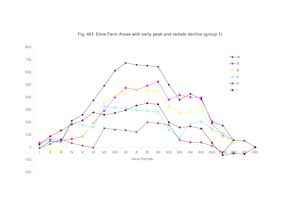
The first group consists of profiles identified by a rate of coin loss that is considerably greater than the British mean for the period up to AD 260, after which coin loss falls off throughout the remainder of the 3rd and 4th centuries (Figure 403). These graphs indicate that areas away from the centre of the settlement produced the earliest coin-loss profiles (Area W is the earliest of all and the furthest away from the centre). Areas B, R and E lie between W and the centre and also produce early profiles, although not so extreme as W (Area R was located within B, which was machine-stripped only, and the profiles for both coin groups are almost identical). Finally, Areas K and I also produced relatively early coin-loss profiles, yet they are on the south-western edge of the perceived settlement centre (the location of Area K to the south of the centre might explain why its profile begins after AD 138, much later than the other early areas). Both K and I differ from the other early area profiles by producing significant quantities of late 4th-century coins (presumably related to their location next to Area J in the centre of the excavated settlement - see below).
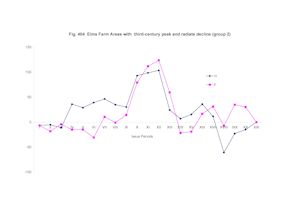
The second group of profiles consists of two areas just to the north of the centre, H and F (Figure 404). Both of these are characterised by average coin loss during the 1st and 2nd centuries, followed by a strong rise in the numbers of coins lost during the first half of the 3rd century. This part of the settlement experienced a steep decline after this date, which lasted for the remainder of the 3rd century (much like the areas in the first group), while the 4th century never deviates much from the mean. The only difference between these two areas occurs at the tail end of the 4th century, when F produces fewer coins than the average while H produces more. This might be explained by the proximity of Area H to Area J where late coins were lost in great quantities, or by the similar natures of the two areas as religious loci.

Areas M, G, L, and D comprise the third group of coin-loss profiles, identified by a shared decline sometime during the early 4th century (although only Area M produced more than twenty coins). Three areas close to the centre of the settlement (M, L and D) all show a steady decline from AD 138 to AD 260, while coins from G show small, sporadic, increases up to this date (Figure 405). Unlike the areas discussed so far, the profiles of the third group all show increasing coin loss during the period from AD 260 to AD 330. The collapse of coin loss occurs late in these areas, during the early 4th century in M, between AD 330 and AD348 in Areas G and L, while the profile for Area D manages to hold on until AD 330 to AD 348. The late influence of Area J can be seen on the profile of the neighbouring L, which experienced a slight return of coin loss at the end of the 4th century.
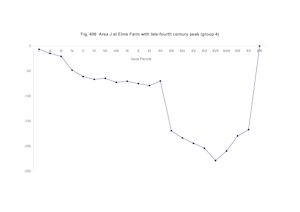
The final figure in this sequence of charts (Figure 406) shows only one area; the profile for Area J represents a unique pattern of coin loss. While every other part of the settlement produced a profile showing a trend of above average coin loss for the first two centuries of the Roman period, Area J does exactly the opposite, with a steady below average rate of loss over this time. Area J then follows most of the other areas with a further drop in the number of coins lost after AD 260, though this downward trend continued until the mid-4th century. The 4th century after AD 364 is very strongly represented in Area J, particularly the years from AD 388-402.
Studies of Romano-British site-finds have shown that sites with different functions exhibit different characteristics, so that, for example, a temple in the countryside might be identifiable from its site-finds, or the coins from coloniae are generally distinguishable from those from small towns. Figure 407 shows the Romano-British sites that are most similar to the profile for Elms Farm/Heybridge. All sites in this graph share a slightly higher than average rate of loss up to the mid-3rd century, the steep decline after AD 260, a decline again from AD 330 to AD 364, and finally the sharp increase in coins lost during the late 4th century, particularly between AD 364 and AD 378. Therefore, the Elms Farm coin-loss profile fits best with a group of sites that includes the late provincial capital at Cirencester, two important late Roman 'small' towns at Dorchester on Thames and Water Newton (Ashton and Thistleton Dyer lie very close to Water Newton), a small settlement in Hertfordshire, and, perhaps significantly, the temple at Chelmsford. The feature that identifies Heybridge from these other sites is the degree of deviation from the British mean - although its coin-loss profile does deviate from the average, it is less pronounced than at all of the other sites.
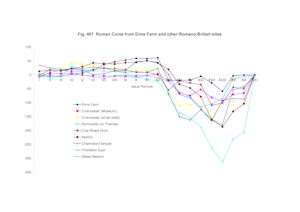
Those coins from areas of the first group (W, B, R, E, K and I) are similar to site-finds from other sites with strong early profiles and a decline after AD 260. These include the military sites at London (Guildhall Museum), Southwark, Richborough, Brecon and the palace at Fishbourne. The second group's profiles (from Areas H and F) are not like any other recorded site (perhaps similar to the coin list from Reculver - R. Reece, pers. comm.), while the third group of areas is most similar to sites such as Braintree, Housesteads, Manchester, Whitton, Exeter and London (leap after AD 260, decline after AD 330). Finally, Area J, with the very late peak, is similar to Cirencester (St Michael's Field), Somerton, Sapperton and Colchester Butt Road (Reece 1995).
Numismatists are aware that the supply of Roman coins to the various provinces of the empire has left an identifiably provincial pattern of coin loss against which assemblages can be compared in order to explore their coin-using histories. Regionality of coin supply has been explored in detail for the counties of Norfolk and Suffolk and these studies form the basis for this analysis of the coins (Davies and Gregory 1991; Plouviez 1995). This section asks whether the Elms Farm coins reflect the settlement's function and role within the local and wider economy, or whether they indicate that Heybridge was a settlement within an East Anglian region of coin supply, probably located towards the south.
To determine whether these differences might be connected with the economy at the regional level or not, coin lists from 100 other Romano-British sites have been collected for comparison with Heybridge (Figure 418 .pdf). Norfolk provides twenty-four coin lists including some excavated groups, though most were recovered during field-walking or by metal-detectorists. The site-finds from forty-seven sites in Suffolk include six small towns, while the remainder are mainly surface finds from rural settlements whose extent and form are imperfectly understood. Coins from a further thirteen sites from Essex have been published and are available for comparison with Heybridge. They are generally from the Roman end of the settlement spectrum, including the colonia at Colchester and the small towns at Braintree, Kelvedon and Great Dunmow. Finally, another sixteen sites from Bedfordshire and Hertfordshire were included to extend the survey westwards from Essex and into the south Midlands.
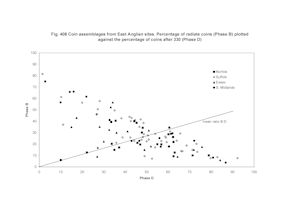
Comparing the quantities of site-finds from the late 3rd century and the period from AD 330-402 has been shown to be a very useful method for distinguishing different groups of sites. Richard Reece has suggested that sites favouring the earlier coins are typically urban settlements, while those that produce greater numbers of 4th-century coins were more rural in nature (Reece 1987b, 17). In their study of the coins from Norfolk, Davies and Gregory found a similar pattern in which rural settlements, and temple sites in particular, produced assemblages with large quantities of 4th-century coins (Davies and Gregory 1991, 75-7). The ratios of coins from AD 260-96 (Phase B) and those from the middle and later 4th century (Phase D) are shown for the 101 sites on Figure 408, where each site is shown according to its home county. While we cannot expect obvious divisions between sites dependant on their location within modern counties, some differences might be anticipated at the extremes, for example between Norfolk and Essex perhaps. It is difficult for the eye to pick out significant constellations from the mass of information on Figure 408 and in order to aid this process the plots for the three counties and one region are shown separately as Figures 409-412.

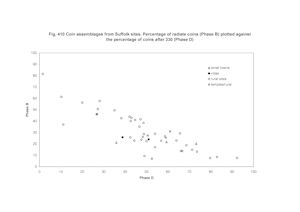
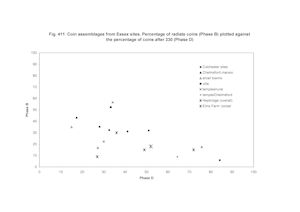
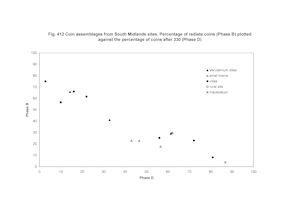
Using these graphs, it is apparent that there is indeed some regional variation within the overall distribution of East Anglian coin assemblages. Early Roman coins are most common from major settlements in Essex and Norfolk, including the Essex small towns of Kelvedon and Braintree. The Suffolk sites are more confined towards the centre of the graph indicating the absence of these early coins in any quantities. That the site-finds from Suffolk are more strung out between the upper left and lower right corners suggests that settlement occupation here was more episodic than in other regions. Sites such as Little Cornard, Hitcham and Alderton lost most coins during the late 3rd and early 4th centuries, while late 4th-century coins are far more common from the settlements at Hinderclay, Edwardstone and Barham. The majority of Norfolk site-finds are found in the centre of the graph and towards the bottom right-hand corner. This indicates that Norfolk received more 4th-century coins than late 3rd-century radiates, which could be a result of relatively depressed radiate supply, or increased use and supply during the later years of the 4th century. Essex sites, other than temples, experienced a decline in coin loss during the first quarter of the 4th century, though the abundance of later 4th-century coins from religious sites shows that coins must have been available to be used in Essex, and that the decline was a result of restricted coin use rather than problems with their supply. Site-finds from the south Midlands region are spread diagonally across the graph indicating, as in Suffolk, a general paucity of Phase A coins and a further division of sites between those with very few Phase D coins and those where these 4th-century issues were most common. There is good evidence, therefore, to support the notion that Romano-British settlements in East Anglia produce coin assemblages whose characteristic features were determined by location within the region. In other words site-finds from Essex, when viewed as a group, form a different pattern from the coins recovered from Norfolk sites.
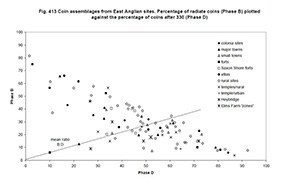
If we now expand the plot of site-finds from East Anglia to show each settlement's function, or type, it should be possible to begin to identify any economic links that might have existed between sites (Figure 413). Two groups of sites are immediately identifiable in the centre of the resulting graph. The first consists of large urban sites such as the colonia at Colchester, the municipium at Verulamium and the civitas capitals at Chelmsford and Venta Icenorum. As expected these sites lie above the B:D mean line and are closely associated with the Saxon Shore forts at Brancaster and Caistor-by-Yarmouth. The second group of sites is situated along the B:D line and comprises several small towns and four extramural sites. Small towns from Suffolk and the south Midlands together form a relatively tight group suggesting that function could also determine a settlement's coin list, even within a region the size of East Anglia where geography was also a determining factor. The comparison of the Saxon Shore forts and their extramural sites is interesting as the forts' site-finds are more erratic. While the intramural sites tend to produce coin assemblages with greater quantities of Phase B radiates as well as Phase D 4th-century coins, the extramural coin lists show a more even distribution between the four coin phases, particularly early coins of Phase A. Of course this method can only identify general trends and there are a number of sites whose coins put them outside the main clusters of settlements. The Culver Street site in Colchester declined too early in the 4th century to fit with the main large town group, while Braintree and Kelvedon in Essex produced more 1st and 2nd century coins than other small towns in East Anglia. Two extramural sites, Colchester Butt Road and Venta South, are situated at the bottom right-hand corner of the graph, together with a group of temples and rural sites in Suffolk with religious significance.
Overall the Heybridge site-finds fit neatly with the group of small towns and extramural sites, lying close to the assemblages from Baldock, Magiovinium, Hacheston and extramural Venta. It is instructive, however, to see how the four 'zones' of coin loss at Heybridge also compare with the overall picture from East Anglia. The first Heybridge zone finds itself with sites that have a majority of Early Roman coins and a decline of coin loss before AD 260 (for example, the temple at Venta and the small town at Braintree). Those areas of Elms Farm that comprise the third zone produced a coin list that is very similar to large town assemblages, with relatively consistent coin use throughout the Roman period but an urban-like ratio of late 3rd and 4th-century coins. The fourth Heybridge zone, on the other hand, is surrounded by religious sites and it is significant that the temples at Great Dunmow and Chelmsford produced similar coin lists.
Comparison of Figure 408 and Figure 413 shows that, while there was certainly some geographically determined variation of coin use in East Anglia during the Roman period, a more significant factor was the similar coin-using histories of specific groups of settlements. Coins of the 1st and 2nd centuries only appear to have circulated among a small number of sites in the region, typically the urban and military centres in Norfolk, the south Midlands and especially Essex. The monetisation of East Anglia involved an increasing use of coins in the more outlying areas of Suffolk and Norfolk during the latter half of the 3rd century and most settlements began to lose coins during this period. After this high point of East Anglian monetisation it becomes a question of when coin use declined at specific sites. By the middle of the 3rd century, just when coin use was becoming increasingly common, certain important settlements, particularly in Essex and the south Midlands, were among the first to experience a decline in the use of coins. This includes two small towns in Essex (Braintree and Kelvedon) and the temples at Venta, Harlow and Crownthorpe. The group of villas close to Verulamium made it to the early 4th century before decline set in, while the large towns in the region lasted until the middle of that century. Coins were still being used in small towns, extramural sites and Saxon Shore forts for rather longer than in the civitas capitals and colonia. By the very end of the Roman period, however, coin use was restricted largely to religious and temple sites, though these might be located within the walls of towns as well as the countryside.
The coins suggest that Heybridge exhibits a pattern of continued coin loss because different parts of the settlement used coins at different times throughout the entire Roman period. The peripheral areas of Heybridge saw the earliest use of coins at the settlement, as well as the earliest decline. Unlike the pattern for Braintree, however, this did not mark the decline of Heybridge as a whole (it must be borne in mind that Braintree has not been as extensively excavated as Heybridge). Instead, coin use extended to other parts of the town becoming increasingly centralised and concentrated during the later 3rd and 4th centuries. The third zone of coin use at Heybridge exhibits strong similarities with the group of large towns in the region and we can speculate whether that was because coin use in this part of Heybridge was linked to the economic fortunes of the nearby civitas capital at Chelmsford and the colonia at Colchester.
A feature of the end of the Roman period in East Anglia, as elsewhere in southern Britain, is the apparent restriction of coin use to religious sites. The presence of the Heybridge temple in Area J resulted in the continued arrival of coins at the settlement even during the late 4th and early 5th centuries. It is possible that spaces around such temples were being used as markets at the end of the Roman period (having replaced earlier marketplaces elsewhere). For several reasons, however, this is unlikely and it seems more appropriate to understand the coinage of the late 4th century as something other than a means of exchange. Firstly, the use of coins in a market would lead to their dispersion beyond the place of exchange, not an overwhelming concentration precisely in that place. Secondly, and more significantly, Late Roman bronze coins found on religious sites are frequently recovered from wells or pits and are often associated with a limited range of other artefacts, particularly toilet implements and bracelets of various types (see Atkinson and Preston 2015, Chapter 6).
Internet Archaeology is an open access journal based in the Department of Archaeology, University of York. Except where otherwise noted, content from this work may be used under the terms of the Creative Commons Attribution 3.0 (CC BY) Unported licence, which permits unrestricted use, distribution, and reproduction in any medium, provided that attribution to the author(s), the title of the work, the Internet Archaeology journal and the relevant URL/DOI are given.
Terms and Conditions | Legal Statements | Privacy Policy | Cookies Policy | Citing Internet Archaeology
Internet Archaeology content is preserved for the long term with the Archaeology Data Service. Help sustain and support open access publication by donating to our Open Access Archaeology Fund.